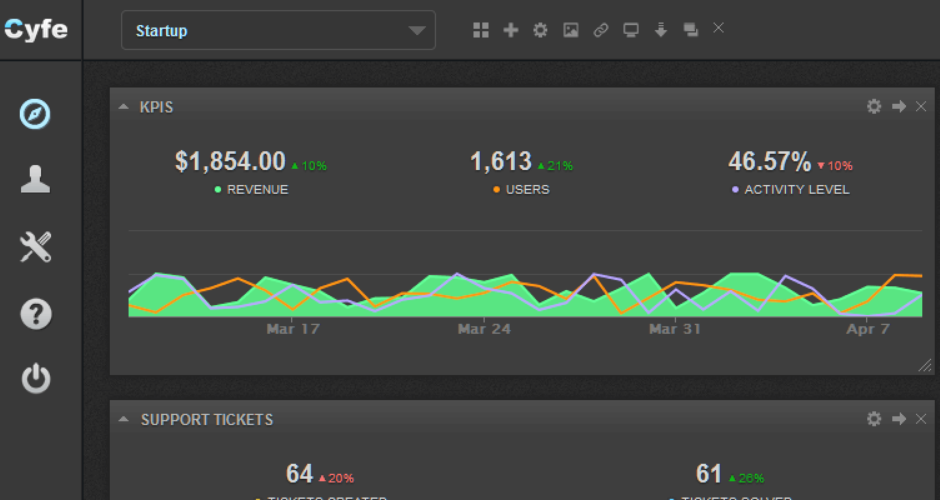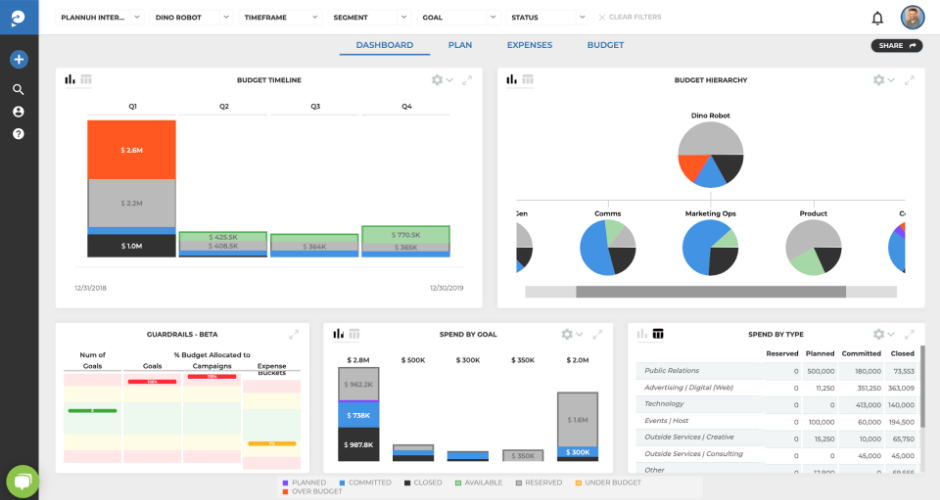Track the impact of your marketing with an ROI dashboard and make better decisions to enhance your customer acquisition.
Marketers are under extreme pressure to prove ROI in order to justify their marketing spend.
In fact, 55% of marketers are tasked with the responsibility of increasing ROI.
But, tracking ROI isn’t straightforward, especially if you have several channels working together to drive your leads and customer acquisition.
However, if you’ve ever landed on our blog before, you’ll know there’s always a solution.
And today, that solution is marketing ROI dashboards.
Keep reading to learn more about marketing ROI dashboards and how they can help provide greater insights into your marketing performance.
In this article, we’ll discuss:
Pro Tip
Ruler is a great tool for tracking and visualising the ROI of your marketing efforts. It tracks your users from awareness to acquisition on an individual level, allowing you to successfully attribute leads and marketing-generated revenue across multiple campaigns, ads, keywords and more.
How Ruler attributes revenue to your marketing
Chances are, you know what a marketing dashboard is and how it works.
In case you don’t know, a marketing dashboard keeps track of your traditional metrics such as traffic, conversions and bounce rate and combines it all in a clear, centralised report.
Marketing ROI dashboards essentially work in the same way, except they focus on critical business metrics.
They’re built to provide a single source of truth by showing you which marketing and sales activities have the most meaningful impact on your revenue.
Tracking return on investment (ROI) is crucial for any successful business, no matter how big or small.
Related: How to measure your marketing ROI
It’s the most reliable way to understand which marketing investments are worthwhile and which aren’t.
There are many marketers that rely on lead quantity to produce more revenue.
But, as any reputable marketer will tell you, leads aren’t guaranteed revenue.
You can have all the leads in the world. But if you can’t close them, they mean nothing to your business.
Let’s say you have two campaigns on Google Ads running simultaneously. They both run for 30-days and cost £1,000.
Campaign A converted 20 leads, whereas Campaign B contributed 7 leads.
| Name | Number of leads | Spend | Cost per lead |
|---|---|---|---|
| Campaign A | 20 | £1,000 | £50 |
| Campaign B | 7 | £1,000 | £142.85 |
In this scenario, if you were handed more budget to increase revenue, where would you invest it?
Most likely, Campaign A.
Now let’s assume we can view the revenue generated from the leads in these campaigns.
Campaign A only managed to drive £2,000 in sales. However, Campaign B pulled in £10,000 in revenue.
| Name | Number of leads | Spend | Revenue | ROAS |
|---|---|---|---|---|
| Campaign A | 20 | £1,000 | £2,000 | 200% |
| Campaign B | 7 | £1,000 | £10,000 | 1000% |
Where would you invest your budget now?
Focusing on leads only gives you a partial picture of your marketing performance. By focusing on revenue, however, you’ll know exactly what does and doesn’t work.
And once you know which channels and campaigns drive the most revenue, you can double down on your most valuable marketing efforts and drive more cost-effective results for your business.
Chances are you’ve landed here through Google. If that’s the case, you’ll know that Google offers marketers a ton of tools and dashboards to track their marketing effectiveness and ROI. But, how do you decide what’s best? Below are a few factors you can take into account during the selection process.
Gaining a complete view of your ROI usually requires integrating data from multiple sources. You must ensure that the platform you opt for integrates with most applications and allows you to consolidate your data and systems.
An ROI dashboard can take many forms and vary in price too. Look out for costs associated with your ROI dashboard. It’s not unusual for providers to charge extra for multiple user accounts, integrations and excessive data usage.
ROI affects many important operating factors at your company. You’ll likely have multiple teams and stakeholders take great interest in your ROI dashboard. With that in mind, you’ll need to invest in a tool that supports multiple user access.
Now you know what to look for, let’s take a look at some powerful solutions to help track your marketing ROI.
To find out how marketing is driving revenue, your best bet is to stick with a tool like Ruler Analytics.
Ruler is a marketing attribution solution. It captures all interactions in an individual customer journey and automatically attributes revenue back to the marketing touchpoints involved in the conversion path.
Here’s a complete rundown of how it works.
Ruler works by tracking each and every visitor over multiple sessions, traffic sources, keywords and more.
Related: How to view full customer journeys in Ruler
In the event of a conversion, whether that’s a form fill, phone call or live chat enquiry, Ruler will take the contact details it’s captured and match them to the lead’s marketing touchpoints.
These conversion details and marketing source data are passed to the CRM. Your sales and customer support teams can see what influenced the lead and what services and products they’re potentially interested in.
Whenever your lead moves to another stage of the pipeline, the data is fed back to Ruler. This allows your marketing team to keep track of leads and determine whether they’re adding enough quality to the later stages of the funnel.
Once that customer finalises their purchase or deal, Ruler accurately attributes the revenue back to the marketing channels, campaigns, keywords and ads that influenced the conversion in the first place.
Related: How Ruler attributes revenue to your marketing
Ruler can integrate with almost any marketing tool or application, allowing you to view revenue and attribution data in tools you use frequently.

Pricing for Ruler starts at £199 a month and it has various plans to suit your specific needs. You can save 20% by paying annually and there are special rates for agency partners.
Pro Tip
Want more information on Ruler and the services we offer? Book a demo to see Ruler in action and learn how it can help evidence your marketing’s impact on revenue.
Schedule a free demo of Ruler
Cyfe is a data visualisation and dashboard reporting solution. It allows you to collect, monitor and analyse your key marketing and business performance metrics in one place. It’s a great tool for marketers that want to look beyond traditional marketing metrics and focus on the bigger picture.

Like most tools in our list, Cyfe is plan based. It has a total of four pricing plans. Starter at $19 per month, Standard at $29 per month, Pro at $49 per month and Premier at $89 per month.
Most of you have heard of HubSpot. It’s a leader in sales and marketing automation. But, it’s also making noise in the marketing attribution and revenue tracking space.
HubSpot works by connecting your CRM and marketing data and allows you to credit different touchpoints at every stage of the customer journey.
Within Hubspot, you can track which marketing campaigns are moving the needle on revenue and make better decisions to improve your strategies.

The downside to HubSpot’s revenue attribution reporting is that it’s only available in the Enterprise package and is untouchable to small to medium businesses.
Pricing is available on request, but the enterprise package does start from £2,624 per month (billed annually at £31,488) for only 10,000 contacts.
Kissmetrics is another tool that can track your best-performing channels in terms of revenue.
It’s a person-based analytics product that helps you identify, understand, and improve the metrics that drive your business forward.
Using the revenue report, you can highlight how much revenue you’ve made from marketing and break it down by campaign to track which one has the highest lifetime value and lowest churn.

There are three pricing tiers for Kissmetrics. Silver at $299 per month, Gold at $499 per month and Custom.
Plannuh is a performance tool that allows you to manage and track your business goals, marketing budget and ROI.
It works by connecting all the tools that marketers use to build plans, budgets and reports. Plannuh consolidates all your marketing data for a single view of your marketing activities.

Pricing for Plannuh is unique, and how much you pay depends on the size of your marketing budget. If your marketing budget is £500,000, you can expect to pay $750 per month.
If you’re not tracking ROI, you’re not effectively measuring your marketing performance.
Rather than guessing which marketing efforts lead to revenue, invest in a ROI dashboard.
With an ROI dashboard, you’ll see how people are engaging your marketing campaigns to buy your products and services. And more importantly, you’ll gain access to data-driven insights that’ll help improve and grow your bottom line.
With tools like Ruler, the process of tracking your ROI couldn’t be any easier.
Ruler takes out the legwork by seamlessly attributing revenue to your marketing across multiple touchpoints, allowing you to focus on building and growing your business.
Want more info on Ruler? Learn how Ruler attributes revenue back to your marketing or book a demo to see how it can improve the quality of your marketing reports.
